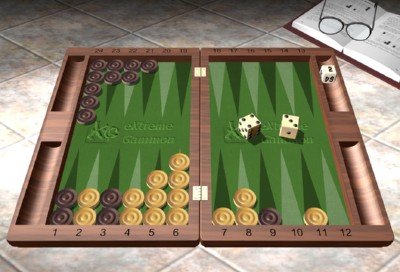Cash game. Black owns the cube. White on move.

White to play 4-3.
Something a little different this time. Identify the worst of these three plays:
(a) 11/7 5/2
(b) 11/4
(c) 7/4 6/2.
This one is actually pretty easy. The worst play is the only completely safe play for this turn, 11/7 5/2. White doesn’t need to be safe in this position. Black is helpless, with a busted board and some loose blots. Black doesn’t want to hit right now; he wants a couple of turns to consolidate his position and hopefully hit later and get off the gammon.
White’s idea should be to put his checkers in a good position for the bearoff. For that, he wants to clear his 7-point and 8-point, and make sure he has plenty of spares on the 4, 5, and 6-points. Playing 11/7 5/2 does all the wrong things: it (1) puts a checker on the 2-point, where it doesn’t belong, and (2) doesn’t put anyone on the 4-point, where White wants spares, and (3) makes a point that White will immediately want to clear. Conceptually, that’s about as bad as you can do.
What about the other two plays? They’re actually very close in equity, if you’re playing a strong player. But if you’re playing a weak player, they’re not close at all: 11/4 is now much better than 7/4 6/2. The reason is that after 11/4, leaving a blot on the bar-point, Black shouldn’t hit unless he rolls 6-6 or 4-4. For any other roll containing a 6 or a 4, the hit is a big mistake, exposing Black to lots of extra gammon losses for relatively few winning chances. Weak players won’t necessarily see this, so leaving the blot on the 7-point can induce a blunder. After 7/4 6/2, however, even weak players will mostly handle the next roll correctly, moving their outfield blot.





